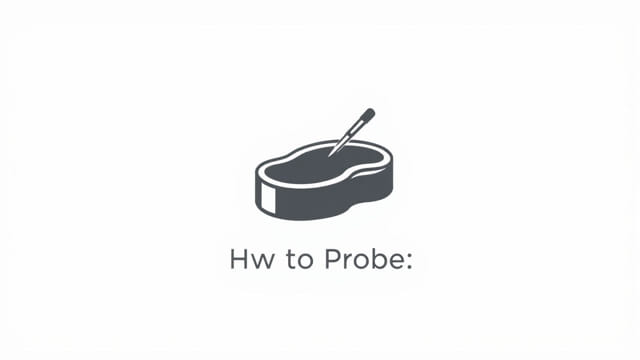Probing meat is an essential step in cooking that ensures your food is safe to eat and perfectly done. Whether you’re grilling a steak, roasting a whole chicken, or smoking a brisket, using a meat probe or thermometer helps you track the internal temperature and prevent undercooking or overcooking. This not only protects you from foodborne illnesses but also enhances the texture, flavor, and juiciness of the meat. Learning how to properly probe meat can make a big difference in your culinary results, and it’s a skill every home cook or pitmaster should master.
Understanding the Purpose of Probing Meat
Before jumping into the steps, it’s important to understand why probing meat is necessary. Different types of meat require different internal temperatures to be considered safe and palatable. Probing ensures:
- Food safety– preventing harmful bacteria such as salmonella or E. coli.
- Precision cooking– achieving the ideal doneness for meat like medium-rare beef or fully cooked poultry.
- Texture and moisture control– avoiding dry, rubbery, or tough meat.
Choosing the Right Meat Thermometer
There are several types of thermometers to choose from when learning how to probe meat correctly. Each one has its pros and cons:
- Instant-read thermometer: Quick results, ideal for checking temps near the end of cooking.
- Leave-in probe thermometer: Inserted before cooking begins; monitors temperature in real time.
- Wireless or Bluetooth thermometer: Offers convenience with real-time updates via apps.
Pick a thermometer that suits your cooking method and experience level. For grilling or smoking, a leave-in probe with digital feedback is especially useful.
How to Properly Probe Meat
1. Locate the Thickest Part
Always insert the meat probe into the thickest part of the meat. This is where it takes the longest to cook, and where the internal temperature gives the most accurate reflection of doneness. For large cuts like turkey, brisket, or roast beef, the thickest part is usually at the center, away from bones and fat.
2. Avoid Bone, Fat, and Gristle
Bones conduct heat differently than muscle tissue, and fat doesn’t offer an accurate reading. Always insert the probe into the flesh, avoiding bone, fat, and connective tissue. If you’re probing chicken or pork chops, aim for the center of the meatiest area.
3. Insert the Probe Correctly
Slide the probe slowly into the meat until you reach the core. Don’t jab or push too hard. For example:
- Chicken or Turkey: Insert into the inner thigh, not touching bone.
- Steak: Probe from the side, toward the center of the thickest part.
- Roast: Enter from the top or side into the middle.
If you’re using a leave-in probe, make sure it’s placed before the meat goes into the oven or smoker.
Recommended Internal Temperatures
Knowing the target temperature is crucial for properly probing meat. Below are USDA-recommended internal temperatures for common meats:
- Beef, Lamb, Veal (medium-rare): 130-135°F (54-57°C)
- Beef, Lamb, Veal (medium): 140-145°F (60-63°C)
- Poultry (whole or ground): 165°F (74°C)
- Pork: 145°F (63°C) with 3-minute rest
- Ground meats (beef, pork, lamb): 160°F (71°C)
- Fish: 145°F (63°C)
These are minimum safe temperatures. Some chefs may choose slightly different levels based on desired texture, but these serve as reliable benchmarks.
Checking Temperature Accurately
For the best results, check the temperature at more than one point, especially with irregular cuts. If you’re cooking a whole chicken or turkey, test both the thigh and breast to confirm doneness throughout. Let the probe sit for a few seconds before reading if you’re using an instant-read model.
Resting the Meat
After you remove the meat from heat, allow it to rest. During this time, internal juices redistribute, and the temperature continues to rise slightly (carryover cooking). Resting ensures a juicier and more flavorful dish. Typical rest times:
- Steak: 5-10 minutes
- Roast: 15-20 minutes
- Poultry: 10-15 minutes
Cleaning and Maintaining Your Meat Probe
After every use, clean your meat probe or thermometer to prevent contamination. Use warm, soapy water and a soft cloth or sponge to wipe it down. For digital models, avoid submerging the probe unless it’s waterproof. Also, calibrate your thermometer regularly to ensure accuracy this is especially important for analog thermometers.
Pro Tips for Probing Meat
- Probe early and often: Begin checking a few minutes before you expect the meat to be done.
- Use multiple probes: For large cuts or multiple pieces, using more than one probe helps monitor overall cooking progress.
- Combine with touch and sight: While probing gives exact temperatures, experienced cooks also rely on visual and tactile cues to judge doneness.
- Label your thermometer: If you use separate probes for meat and candy making, avoid cross-contamination by labeling them.
Common Mistakes to Avoid
Even with the right tools, incorrect probing techniques can lead to misleading temperature readings. Avoid these errors:
- Probing too close to bone or fat
- Removing the probe too quickly
- Not cleaning the thermometer between uses
- Using the same probe for different meats without sanitizing
Practicing good habits leads to better, safer meals every time.
Learning how to probe meat correctly is a valuable cooking skill that enhances safety, consistency, and taste. With the right thermometer and proper technique, you’ll be able to cook meats to perfection whether it’s juicy steaks, tender roasts, or perfectly cooked poultry. Take your time, follow temperature guidelines, and treat probing as an essential part of your cooking routine. Once you master this process, your meals will not only be safer but also more delicious, juicy, and enjoyable for everyone at the table.
